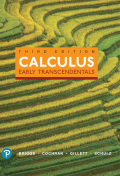
Concept explainers
Wave equation Traveling waves (for example, water waves or electromagnetic waves) exhibit periodic motion in both time and position. In one dimension, some types of wave motion are governed by the one-dimensional wave equation
where u(x, t) is the height or displacement of the wave surface at position x and time t, and c is the constant speed of the wave. Show that the following functions are solutions of the wave equation.
78. u(x, t) = 5 cos (2(x + ct)) + 3 sin (x – ct)
Want to see the full answer?
Check out a sample textbook solution
Chapter 15 Solutions
Calculus: Early Transcendentals (3rd Edition)
Additional Math Textbook Solutions
Algebra and Trigonometry (6th Edition)
Calculus: Early Transcendentals (2nd Edition)
College Algebra with Modeling & Visualization (5th Edition)
A Problem Solving Approach To Mathematics For Elementary School Teachers (13th Edition)
Elementary Statistics
Elementary Statistics: Picturing the World (7th Edition)
- x4 -289 Consider the function f(x) = 2 X-17 Complete parts a and b below. a. Analyze lim f(x) and lim f(x), and then identify the horizontal asymptotes. x+x X--∞ lim 4 X-289 2 X∞ X-17 X - 289 lim = 2 ... X∞ X - 17 Identify the horizontal asymptotes. Select the correct choice and, if necessary, fill in the answer box(es) to complete your choice. A. The function has a horizontal asymptote at y = B. The function has two horizontal asymptotes. The top asymptote is y = and the bottom asymptote is y = ☐ . C. The function has no horizontal asymptotes. b. Find the vertical asymptotes. For each vertical asymptote x = a, evaluate lim f(x) and lim f(x). Select the correct choice and, if necessary, fill in the answer boxes to complete your choice. earrow_forwardExplain why lim x²-2x-35 X-7 X-7 lim (x+5), and then evaluate lim X-7 x² -2x-35 x-7 x-7 Choose the correct answer below. A. x²-2x-35 The limits lim X-7 X-7 and lim (x+5) equal the same number when evaluated using X-7 direct substitution. B. Since each limit approaches 7, it follows that the limits are equal. C. The numerator of the expression X-2x-35 X-7 simplifies to x + 5 for all x, so the limits are equal. D. Since x²-2x-35 X-7 = x + 5 whenever x 7, it follows that the two expressions evaluate to the same number as x approaches 7. Now evaluate the limit. x²-2x-35 lim X-7 X-7 = (Simplify your answer.)arrow_forwardA function f is even if f(x) = f(x) for all x in the domain of f. If f is even, with lim f(x) = 4 and x-6+ lim f(x)=-3, find the following limits. X-6 a. lim f(x) b. +9-←x lim f(x) X-6 a. lim f(x)= +9-←x (Simplify your answer.) b. lim f(x)= X→-6 (Simplify your answer.) ...arrow_forwardEvaluate the following limit. lim X-X (10+19) Select the correct answer below and, if necessary, fill in the answer box within your choice. 10 A. lim 10+ = 2 ☐ (Type an integer or a simplified fraction.) X-∞ B. The limit does not exist.arrow_forwardFind the following limit or state that it does not exist. x² +x-20 lim x-4 x-4 Select the correct choice below and, if necessary, fill in the answer box to complete your choice. A. lim x²+x-20 x-4 (Type an exact answer.) x→4 B. The limit does not exist.arrow_forwardDetermine the intervals on which the following function is continuous. f(x) = x - 5x + 6 2 X-9 On what interval(s) is f continuous? (Simplify your answer. Type your answer in interval notation. Use a comma to separate answers as needed.)arrow_forwardFind the following limit or state that it does not exist. 2 3x² +7x+2 lim X-2 6x-8 Select the correct choice below and, if necessary, fill in the answer box to complete your choice. A. lim 3x²+7x+2 6x-8 (Simplify your answer.) X-2 B. The limit does not exist.arrow_forwardFind the following limit or state that it does not exist. X-2 lim x-2 5x+6 - 4 Select the correct choice below and, if necessary, fill in the answer box to complete your choice. O A. lim X-2 X-2 15x+6 = (Type an exact answer.) - 4 B. The limit does not exist.arrow_forward(a) Sketch the graph of a function that is not continuous at 1, but is defined at 1. (b) Sketch the graph of a function that is not continuous at 1, but has a limit at 1. (a) Which of the following graphs shows a function that is not continuous at 1, but is defined at 1. ○ A. Ay ✓ B. 5 X ✓ (b) Which of the following graphs shows a function that is not continuous at 1, but has a limit at 1. ○ A. B. X y 5- -5 5 ✓ ✓ 5 ☑ 5 X y ☑ LVarrow_forwardIf lim f(x)=L and lim f(x) = M, where L and M are finite real numbers, then what must be true about L x-a x-a+ and M in order for lim f(x) to exist? x-a Choose the correct answer below. A. L = M B. LMarrow_forwardDetermine the following limit, using ∞ or - ∞ when appropriate, or state that it does not exist. lim csc 0 Select the correct choice below, and fill in the answer box if necessary. lim csc 0 = ○ A. 0→⭑ B. The limit does not exist and is neither ∞ nor - ∞.arrow_forwardIs the function f(x) continuous at x = 1? (x) 7 6 5 4 3 2 1 0 -10 -9 -8 -7 -6 -5 -4 -3 -2 -1 0 1 2 3 4 5 6 7 8 9 10 -1 -2 -3 -4 -5 -6 -71 Select the correct answer below: The function f(x) is continuous at x = 1. The right limit does not equal the left limit. Therefore, the function is not continuous. The function f(x) is discontinuous at x = 1. We cannot tell if the function is continuous or discontinuous.arrow_forwardarrow_back_iosSEE MORE QUESTIONSarrow_forward_ios
- Algebra & Trigonometry with Analytic GeometryAlgebraISBN:9781133382119Author:SwokowskiPublisher:Cengage
